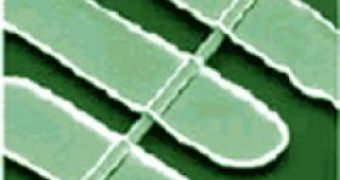A nanowire is a wire of dimensions the size of a nanometer (a billionth of a meter). Alternatively, nanowires can be defined as structures that have a lateral size constrained to tens of nanometers or less and an unconstrained longitudinal size. At these scales, quantum mechanical effects are important - hence such wires are also known as "quantum wires". Molecular nanowires are composed of repeating molecular units either organic (DNA) or inorganic.
The nanowires could be used, in the near future, to link tiny components into extremely small circuits, and their geometry makes them uniquely suited for light detection, to be used for sensing, imaging, memory storage, intrachip optical communications and other nanoscale applications.
"Different kinds of nanowires detect different wavelengths of light. You could make a red-green-blue photodetector on the nanoscale by combining the right three kinds of nanowires," said Cesare Soci, one of two primary authors of a paper describing the new finds.
In order to make a nanowire serve as a photodetector, photons of light with sufficient energy must hit it in such a way that electrons are split from their positively charged holes. Electrons must remain free from their holes long enough to zip along the nanowire and generate electric current under an applied electric field, a sure sign that light has been detected.
The geometry of nanowires, with a lot more surface area compared to volume, as the new research shows, makes them inherently good at trapping holes. Dangling bonds on vast nanowire surfaces trap holes; and when holes are trapped, the time it takes electrons and holes to recombine increases.
Delaying the reunion of an electron and its hole increases the number of times that electron travels down the nanowire, which, in turn, triggers an increase in current and results in "internal photoconductive gain."
In the new work, short pulses of ultraviolet light (hundreds of femtoseconds wide) were detected on time scales in the nanosecond range. Moreover, using electronic measurement of photocurrent, the engineers reported internal photoconductive gain (G) as high as one hundred million - one of the highest ever reported.
This theoretical work showed that light-induced conductivity in nanowires can be increased by more than 10 times over similar bulk structures under the same illumination level and provides further support for the idea that nanowires will be increasingly incorporated into photodetection and photovoltaic applications.

 14 DAY TRIAL //
14 DAY TRIAL //